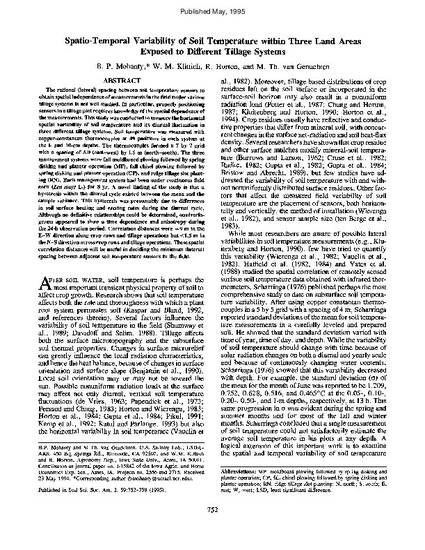
The rational (lateral) spacing between soil temperature sensors to obtain spatial independence of measurements in the field under various tillage systems is not well studied. In particular, properly positioning sensors in a tillage plot requires knowledge of the spatial dependence of the measurements. This study was conducted to measure the horizontal spatial variability of soil temperature and its diurnal fluctuation in three different tillage systems. Soil temperature was measured with copper-constantan thermocouples at 49 positions in each system at the 1- and 10-cm depths. The thermocouples formed a 7 by 7 grid with a spacing of 3.0 (east-west) by 1.5 m (north-south). The three management systems were fall moldboard plowing followed by spring disking and planter operation (MP), fall chisel plowing followed by spring disking and planter operation (CP), and ridge tillage slot planting (RN). Each management system had been under continuous field corn (Zea mays L.) for 8 yr. A novel finding of the study is that a hysteresis within the diurnal cycle existed between the mean and the sample variance. This hysteresis was presumably due to differences in soil surface heating and cooling rates during the diurnal cycle. Although no definitive relationships could be determined, semivariograms appeared to show a time dependence and anisotropy during the 24-h observation period. Correlation distances were ≈9 m in the E-W direction along crop rows and tillage operations but <1.5 m in the N-S direction across crop rows and tillage operations. These spatial correlation distances will be useful in deciding the minimum (lateral) spacing between adjacent soil temperature sensors in the field.
Available at: http://works.bepress.com/robert-horton/32/

This article is published as Mohanty, B. P., M. Th van Genuchten, W. M. Klittich, and R. Horton. "Spatio-temporal variability of soil temperature within three land areas exposed to different tillage systems." Soil Science Society of America Journal 59, no. 3 (1995): 752-759. Doi; 10.2136/sssaj1995.03615995005900030017x.